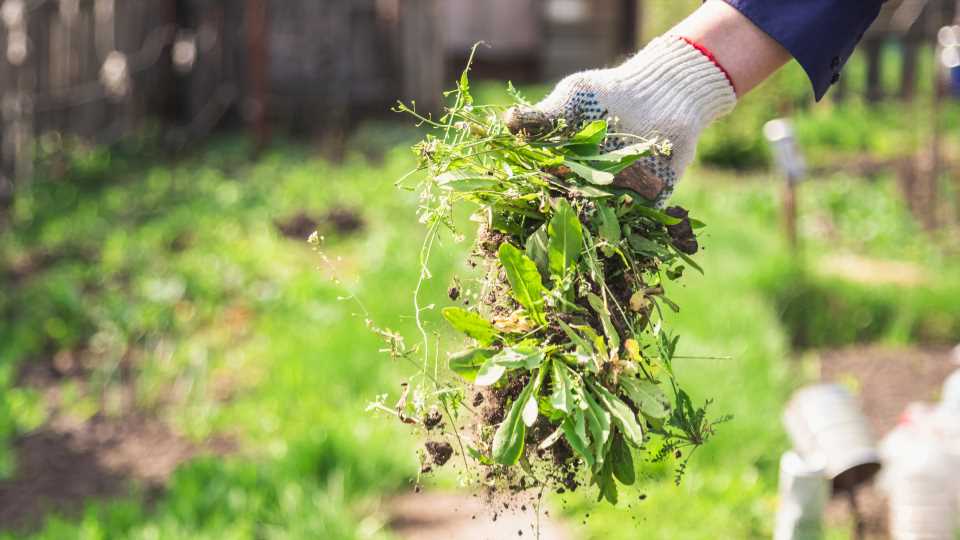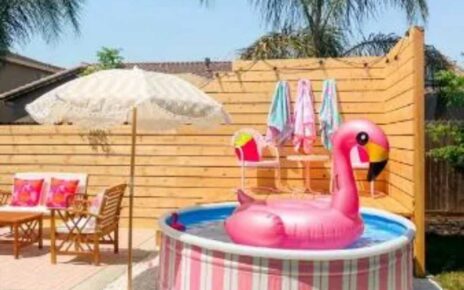GARDENERS can use a cheap and easy hack to banish weeds from their plants – and it's "surprisingly effective."
William Mitchell is a gardening pro at Sutton Manor Nursery who said you don’t have to spend a lot to get rid of your yard’s weeds.
All you need are your bare hands.
The expert recommended pulling them out from the ground yourself or using tools to do so if the root is too deep.
“This will come at zero cost and is surprisingly effective,” Mitchell revealed.
To do so with a weeding tool, cut the weed off at the root, rip it out, and throw it away so that you don’t leave behind discharged seeds that might cause regrowth.
If you want to do it by hand, tackle the problem after a downpour of rain, as the water will soften the soil and make it easier to pull.
Follow our Gardening tips blog for updates...
- By Amanda Castro
Gardening trends you’ll want to avoid this summer
Like most things, gardening comes with seasonal trends.
Various experts predict some of the trends that’ll be flooding your Pinterest boards and social media channels once summer kicks in.
They’ve warned people to steer clear of trends that, while popular, will make your garden look tacky and prevent your plants from flourishing over the summer.
They suggest avoiding the following trends,
- Overplanting
- Artificial grass
- Colorful fences
Be aware of fungus gnats
Fungus gnat infestations are common for gardeners in the summer, but there are plenty of DIY solutions to get them out of the house or garden.
Fungus gnats will infest soil, potting mix, other container media, and other sources of organic decomposition.
Their larvae primarily feed on fungi and organic matter in the soil, but also chew roots and can be a problem in greenhouses, nurseries, potted plants, and interior plantscapes.
How to get gnats out of your house
You can get pesky bugs out of your house this summer by making a simple solution with four ingredients that you probably already have lying around the house.
A plant expert named Amyrah shared on social media that she got rid of her fungus gnat infestation with a simple concoction of honey, vinegar, sugar, and dish soap.
Amyrah left a plate of the mixture out near her plants and found a dish full of dead gnats the next day.
The honey, vinegar, and sugar will attract the insects but the dish soap kills them on the spot.
- By Amanda Castro
Hanging a water bottle
You could create another slow-release watering system by hanging a plastic bottle over your plants.
Simply take a bottle, pierce tiny holes in the bottom half, and then enclose the bottle in a sock – other fabric should work just as fine.
You can then hang this above your plant by securing it to a stick that rests inside of your plant pot – but make sure it’s done so securely.
Just like with the “magic” burying method, the plants will have a steady flow of water.
- By Amanda Castro
Water your plants with a ‘magic’ water bottle trick
Gardening experts have said that a cheap, plastic water bottle can be an eco-friendly watering tool for gardeners.
“Using a plastic water bottle to create a simple, yet effective, watering system is a great solution to repurpose an item that could otherwise end up in a landfill,” expert Sara Dixon said.
To make the irrigation system, simply poke holes in the water bottle and cover it with a sock or another piece of fabric before burying it inside of the planter – with the opening visible at the top of the soil.
The small holes mean the bottle will act as a slow-release watering system.
- By Amanda Castro
Regrow celery or lettuce
Another common vegetable that you can regrow is celery.
Chop off the bottom of the stalk and put it in a bowl with a bit of water, being careful not to submerge the scrap fully. Then let it grow for a week or so before transferring it to soil.
According to the folks at Farmers’ Almanac, it’s sensible to try this one out in the Spring because it grows better in cooler weather.
You can use a similar process to regrow Romaine lettuce from scraps.
If you want to grow your own garlic, all you have to do is save one of the cloves from the bulb you bought at the store.
The gardening experts say you can just plant the bulb directly in your garden and watch it grow.
- By Amanda Castro
Regrow your green onions
Green onions are one of the easiest veggies to test your kitchen scrap gardening skills.
Take the white end of the onion, with its roots intact, and re-plant it in potting soil.
The place it in a sunny window and keep it watered, the publication says.
It can take less than two weeks until the plant will be tall enough to snip the top off and add to your next meal.
- By Amanda Castro
Grow your own food with kitchen scraps
The kitchen scraps you usually toss in the trash can actually be used to grow your own food, according to a gardening expert.
In an online post, the gardening experts at Farmer’s Almanac say you can build a surprisingly robust garden by regrowing vegetable scraps into plants.
“Kitchen scrap gardening is the ultimate in recycling,” the Farmer’s Almanac writes.
“It’s environmentally friendly, can save on grocery bills, and it’s a fun, hands-on science lesson for young children.”
The periodical lists a dozen veggies that are great for kitchen scrap gardening, with tips for how to blossom them into fully growing vegetables.
- By Amanda Castro
Best time to remove weeds revealed
De-weeding after a spell of rain could save you a lot of time and hassle and lead to a healthier garden, according to One Good Thing.
You’ll have a much easier time removing weeds when the ground is wet because damp soil is more flexible and should allow you to rip out the root of a weed intact.
Yes, there is an extra mess but it’s much easier than trying to dislodge weeds when the ground is rock-hard.
It also minimizes ripping the body from the stem, getting a clean sweep instead.
- By Amanda Castro
How to make cut flowers last longer
Cut flowers can last for weeks with just three simple household items: sugar, bleach, and optional fresh lemon juice.
It’s also important to change the water often and trim the stems.
About a teaspoon of sugar and a drop of two or bleach will combine with the flower’s water to help the plants stay fresh.
- By Amanda Castro
Worst flowers for allergies
Seasonal allergies can start swirling with new dust and pollen in the air, but some specific flowers can make things worse for those with hay fever:
- Daisies
- Sunflowers
- Baby’s breath
$4 weed killer
According to the experts, the secret to a weed-free garden and lawn is lime, and no, it’s not the kind you eat.
Lime used in gardens is made from crushed-up limestone, rock, or dolomite, and when applied to soil, it raises the pH level, making the soil less acidic.
Lime also contains magnesium and calcium, which are vital for a healthy garden.
It’s actually the lack of calcium in soil that provides the condition for weeds to thrive in.
USDA Plant Hardiness Zone 11: 40 to 50
Zone 11 is reserved for Hawaii and can only withstand tropical plants.
You can garden anytime here as winter weather is a rare occurrence.
The best tropical plants to garden in Hawaii include,
- Lime
- Sago palm
- Grevillea
USDA Plant Hardiness Zone 10: 30 to 40
It’s getting hotter in zone ten, as this region rarely has cold winters.
This zone is specific to Southern California and Florida where it’s best to plant as early as mid-January.
These plants include,
- Bougainvillea
- Golden shower
- Ensete
- Lemon eucalyptus
- Rubber plant
- Violet churcu
- Royal palm
- Palmetto palm tree
USDA Plant Hardiness Zone 9: 20 to 30
Zone nine plants must withstand high temperatures as it includes California, Southern Texas, Louisiana, and Florida.
It’s best to garden early here in mid-February and plant recommendations include,
- Asparagus fern
- Dahlia
- Tasmanian blue gum
- Fuchsia
- Silk-oak
- Sweetshade tree
- California pepper tree
- Australian bush cherry
- By Amanda Castro
USDA Plant Hardiness Zone 8: 10 to 20
Zone eight includes many of the warmer states that rarely have cold winters like Texas, Louisiana, Mississippi, Alabama, Georgia, and the Carolinas.
The best time to garden here is mid-March due to how hot it can get.
Plant recommendations include,
- Strawberry tree
- Mexican orange
- Hibiscus
- New Zealand daisy-bush
- Japanese pittosporum
- Cherry-laurel
- Texas mountain laurel
- Laurustinus
- Yucca
USDA Plant Hardiness Zone 7: 0 to 10
This region rarely experiences negative degrees.
These states include Washington, Oregon, upper Texas, Oklahoma, Virginia, and North Carolina.
The best time to plant here is mid-April and these plants include,
- Bigleaf maple
- Atlas cedar
- Bleeding heart
- English holly
- Magnolia tree
- Texas rock rose
- Kurume azalea
- English yew
USDA Plant Hardiness Zone 6: -10 to 0
Zone six can reach temperatures below 0 degrees but is generally a warmer area.
This region includes the Pacific Northwest such as Washington, Oregon, Kansas, Missouri, Illinois, and Ohio.
It’s best to plant here in mid-April and you’ll have the best luck with plants such as,
- Japanese maple
- Common boxwood
- Coralbells
- American holly
- Weeping willow
USDA Plant Hardiness Zone 5: -20 to -10
Zone five includes parts of the Midwest and Northeastern states like Colorado, Nebraska, Iowa, Wisconsin, Illinois, Indiana, Michigan, and New York.
The best time to plant in this zone is during mid-April and the following plants thrive best in this atmosphere,
- Flowering dogwood
- Delphinium
- Slender deutzia
- Boston ivy
- Sycamore tree
- Japanese yew
USDA Plant Hardiness Zone 4: -30 to -20
Zone four includes areas with temperatures as low as 30 degrees Farenheit such as Montana, Wyoming, North Dakota, South Dakota, Minnesota, Wisconsin, and Eastern states such as Northern New York, New Hampshire, and Maine.
The best time to plant here is mid-May and plants that do the best are,
- Sugar maple
- Panicle hydrangea
- Chinese juniper
- Vanhouffe spirea
- Crabapple tree
USDA Plant Hardiness Zone 3: -40 to -30
Most plants native to the US can grow between zones three and ten.
Zone three includes the upper Midwest including parts of Montana, North Dakota, Minnesota, Wisconsin, and Maine.
The best time to garden if you’re in zone three is during mid-May.
Plants that thrive in this zone are,
- Foxglove
- Wood fern
- Smooth hydrangea
- Common juniper
- Siberian crabapple
- Goldenrod
- American arborvitae
- By Amanda Castro
USDA Plant Hardiness Zone 2: -50 to -40
Zone two includes cities in Alaska and the northernmost tip of Minnesota where temperatures can drop to below 40 degrees Fahrenheit.
It’s also best to plant during mid-June and prioritize plants such as,
- Paper birch
- Bunchberry dogwood
- Silverberry
- Eastern larch
- Bush cinquefoil
- American cranberry bush
USDA Plant Hardiness Zone 1: Below -50
Zone 1 indicates temperatures that can get under 50 degrees Fahrenheit.
The majority of gardeners don’t have to worry about Zone 1 planting, but if you live in some parts of Alaska this may apply.
The best time to plant in this zone is mid-June and plants that thrive in these low temperatures are,
- Netleaf willow
- Dwarf birch
- Crowberry
- Quaking aspen
- Pennsylvania cinquefoil
- Lapland rhododendron
Hardiness zones explained
The USDA Plant Hardiness Zone Map is used to determine which plants grow best where.
The map is color-coded based on the average annual minimum temperature.
There are 11 zones included on the map with lower numbers indicating colder regions.
A resurgence in gardening thanks to Covid-19
During the early months of the Covid-19 pandemic, spikes in an interest in gardening were reported by many media outlets, according to The Ecological Society of America (ESA)
The exact reason for the spikes has not been determined, but the ESA reported that the spikes are being investigated further.
Source: Read Full Article


